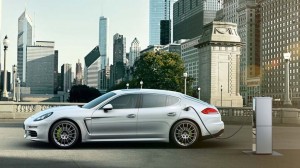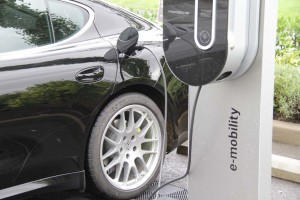Porsche is charged up about the opportunities for its new plug-in hybrid, the 2014 Panamera S-E, with sales forecast to nearly double those of the conventional hybrid model it will replace.
The S-E is one of 10 different versions of the 2014 Porsche Panamera – nine of which the maker plans to offer in the United States. With its lithium-ion battery pack, the new S-E model will be able to go an estimated 22 miles per charge while operating in battery-only mode at speeds up to 84 mph.
But unlike other plug-ins currently on the market, there’s no real trade-off in performance, the coupe-like sedan launching from 0 to 60 in 5.2 seconds, according to Porsche.
“It’s a real Porsche, and a Porsche must go really fast,” even if it is powered by batteries, said Stefan Utsch, director of sales and marketing for the Panamera line.
Porsche became the first German automaker to put a plug-in into production when the Panamera S-E reached European showrooms in August. U.S. sales begin in November at a price of $99,000. The vehicle qualifies for a $4,750 federal tax credit, due to the size of its battery — a 9.4 kilowatt-hour lithium-ion pack – and additional incentives in states like California.
The 2013 Panamera S conventional hybrid came in at $93,200 during the 2013 model-year. But as a result of the federal tax credit – and when factoring in standard equipment added to the Panamera S-E, such as its adaptive suspension – Porsche officials contend that the plug-in actually costs about $2,000 less.
(Mercedes to offer a plug-in version of new S-Class. For more on the S500, Click Here.)
Whatever the math, Porsche officials anticipate a sizable jump in sales. The S Hybrid accounted for about 6% of total Panamera volume for the 2013 model-year. The official forecast is that the Panamera S-E plug-in will jump to at least 10%, if not higher, once it goes on sale in the U.S.
It could find a strong market in other parts of the world, meanwhile, especially in China where the government is trying to push the switch to electric propulsion as a way to address the country’s endemic air pollution problems. Battery-based vehicles also can get around the lotteries now used to reduce congestion in key cities such as Shanghai and Beijing by limiting new vehicles registrations. In Europe, meanwhile, a number of cities are considering restricting access to urban cores to only battery-based vehicles, while others, like London, may exempt electrics from congestion taxes.
(First look: BMW i8 plug-in sports car. Click Here.)
The S-E marries a single electric motor with a supercharged 3.0-liter V-6 to yield a combined 416 horsepower and 435 pound-feet of torque. The package is only a fraction of a second slower than a conventionally powered Panamera and can reach a top speed of 167 mph when the two sources of power kick in.
The plug-in features four different driving modes, including one that operates on electric power alone unless the battery is drained – or the driver demands a burst of acceleration. Notably, the E-Charge mode allows the lithium-ion battery to recharge while the gasoline engine takes over.
Depending upon what the car is plugged into, recharging times can run anywhere from two to almost eight hours. The new 2014 Porsche Panamera S-E does not have the capability of using the new Level III rapid chargers just beginning to pop up around the country, though Utsch said that capability might be added as part of a future update.
Porsche has had a history of delivering surprises to sports car traditionalists, notably with such models as the Cayenne SUV and the 4-door Panamera. But while many might find it unlikely to see a company known for its performance products turning to battery power, company officials insist it’s a logical next step considering both the advances being made in electrification and the new mileage and emissions mandates going into effect around the world.
German rivals are all working up new plug-ins, such as the Mercedes-Benz S500, the Audi A3 e-tron and the new BMW i8. Even such supercar makers as Ferrari and McLaren are using hybrid systems in some of their newest and most expensive offerings.
(For more on the e-tron and other new Audi A3 models, Click Here.)
Porsche, in fact, recently revealed another plug-in, the 887-horsepower 918. That model will cut an owner’s 0 to 60 time to a mere 2.8 seconds, albeit for a starting price of $845,000.



The tree huggers can tel their friends how environmentally friendly they are with their electric Porsche.